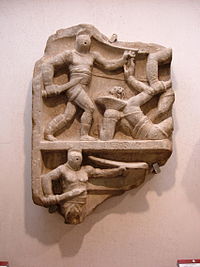
A gladiator was an armed combatant who entertained audiences in the Roman Republic and Roman Empire in violent confrontations with other gladiators, wild animals, and condemned criminals. Some gladiators were volunteers who risked their lives and their legal and social standing by appearing in the arena. Most were despised as slaves, schooled under harsh conditions, socially marginalized, and segregated even in death.
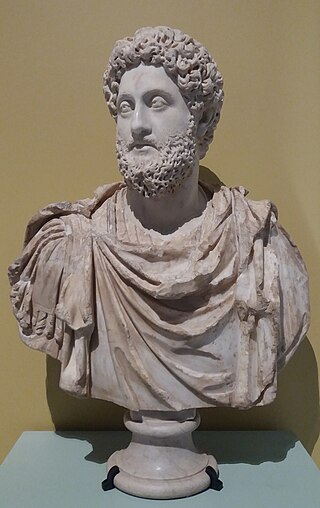
Commodus was a Roman emperor who ruled from 177 to 192. He served jointly with his father Marcus Aurelius from 177 until the latter's death in 180, and thereafter he reigned alone until his assassination. His reign is commonly thought to mark the end of a golden age of peace and prosperity in the history of the Roman Empire.
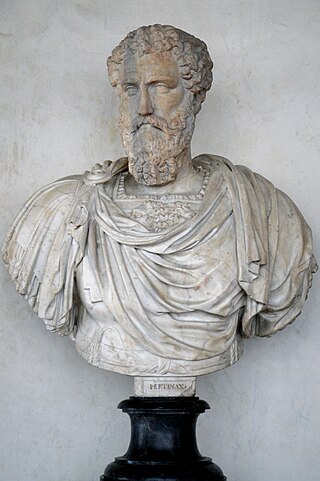
Publius Helvius Pertinax was Roman emperor for the first three months of 193. He succeeded Commodus to become the first emperor during the tumultuous Year of the Five Emperors.

Marcus Didius Julianus was Roman emperor from March to June 193, during the Year of the Five Emperors. Julianus had a promising political career, governing several provinces, including Dalmatia and Germania Inferior, and defeated the Chauci and Chatti, two invading Germanic tribes. He was even appointed to the consulship in 175 along with Pertinax as a reward, before being demoted by Commodus. After this demotion, his early, promising political career languished.
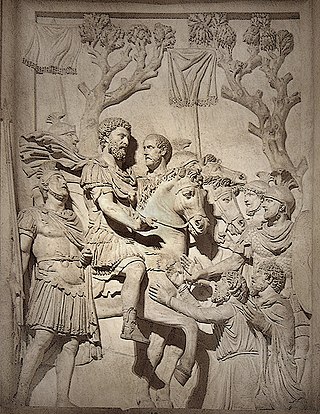
Tiberius Claudius Pompeianus was a politician and military commander during the 2nd century in the Roman Empire. A general under Emperor Marcus Aurelius, Pompeianus distinguished himself during Rome's wars against the Parthians and the Marcomanni. He was a member of the imperial family due to his marriage to Lucilla, a daughter of Marcus Aurelius, and was a key figure during the emperor's reign. Pompeianus was offered the imperial throne three times, though he refused to claim the title for himself.
Herodian or Herodianus of Syria, sometimes referred to as "Herodian of Antioch", was a minor Roman civil servant who wrote a colourful history in Greek titled History of the Empire from the Death of Marcus in eight books covering the years 180 to 238. His work is not considered entirely reliable, although his less biased account of Elagabalus may be more useful than that of Cassius Dio. Herodian himself may have been a Syrian, though he appears to have lived for a considerable period of time in Rome, possibly without holding any public office. From his extant work, it seems that he was still living at an advanced age during the reign of Gordianus III, who ascended the throne in 238. Beyond this, nothing is known of his life.
Narcissus was a Roman athlete, likely a wrestler, from the 2nd century AD. He assassinated the Roman emperor Commodus in 192 AD.
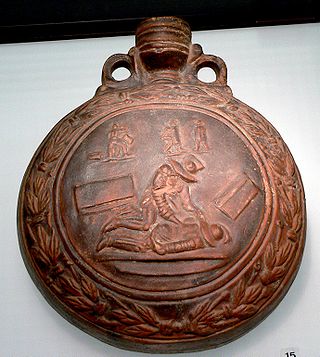
The murmillo was a type of gladiator during the Roman Imperial age. The murmillo-class gladiator was adopted in the early Imperial period to replace the earlier Gallus, named after the warriors of Gaul. As the Gauls inhabiting Italy had become well integrated with the Romans by the time of the reign of Augustus, it became undesirable to portray them as enemy outsiders; the Gallus-class gladiator thus had to be retired.

A retiarius was a Roman gladiator who fought with equipment styled on that of a fisherman: a weighted net, a three-pointed trident, and a dagger (pugio). The retiarius was lightly armoured, wearing an arm guard (manica) and a shoulder guard (galerus). Typically, his clothing consisted only of a loincloth (subligaculum) held in place by a wide belt, or of a short tunic with light padding. He wore no head protection or footwear.
Saoterus was a Bithynian Greek freedman from Nicomedia who served as the Roman Emperor Commodus's palace chamberlain. His career is sketched by Herodian, Dio Cassius and the Historia Augusta. Commodus preferred to exercise his rule through palace officials and Saoterus was the first of these; Saoterus was seen as in the Emperor's favour at the outset of his reign, as he accompanied Commodus in his chariot when he made his ceremonial entry into Rome on 22 October 180. Commodus placed him in a high position in his government, resulting in resentment from noble senatorial families. The Historia Augusta, apparently drawing on the testimony of Marius Maximus, insinuates that Commodus had a homosexual infatuation with Saoterus. After the attempt on Commodus's life in 182, Saoterus was implicated in the plot by the praetorian prefect Tigidius Perennis, and was murdered by the freedman Cleander, who succeeded him as chamberlain.

Marcia Aurelia Ceionia Demetrias was the alleged mistress (182–193) and one of the assassins of Roman Emperor Commodus. Marcia was likely to have been the daughter of Marcus Aurelius Sabinianus Euhodius, a freedman of the co-emperor Lucius Verus.

A hoplomachus was a type of gladiator in ancient Rome, armed to resemble a Greek hoplite. The hoplomachus would wear a bronze helmet, a manica on his right arm, loincloth (subligaculum), heavy padding on his legs, and a pair of high greaves reaching to mid-thigh. His weapons were the spear and a short sword. He was often pitted against the murmillo, perhaps as a re-enactment of Rome's wars in Greece and the Hellenistic East. The name hoplomachus means 'armored fighter'. The small, round shield was as much a weapon as a sword or spear, not unlike the original hoplites, who used it primarily for defensive purposes, but also employed it in their charges, using it to ram their opponents at the onset of a fight. They wore no shoes so the sand would chafe their feet, presenting them a greater challenge.
Marcus Aurelius Cleander, commonly known as Cleander, was a Roman freedman who gained extraordinary power as chamberlain and favourite of the emperor Commodus, rising to command the Praetorian Guard and bringing the principal offices of the Roman state into disrepute by selling them to the highest bidder. His career is narrated by Dio Cassius, Herodian and the Historia Augusta.

The Gladiator Mosaic is a famous set of 5 large mosaics of gladiators and venators and two smaller ones. The mosaics are dated to the first half of the 4th century and are now installed in the Salone of the Galleria Borghese in Rome. They were discovered in 1834 on the Borghese estate at Torrenova, on the Via Casilina outside Rome. Prince Francesco Borghese Aldobrandini requested the excavations be completed. It is believed to have decorated a cryptoporticus of an inner peristylum for a large domus. The mosaics were removed from excavations and restored by Gaetano Ruspi and Filippo Scaccia in 1839. These panels reinvigorated the Borghese Collection after it had shrunk following the sale of much of the collection to Napoleon I.
Sextus Tigidius Perennis served as Praetorian Prefect under the Roman emperor Commodus. Perennis exercised an outsized influence over Commodus and was the effective ruler of the Roman Empire. In 185, Perennis was implicated in a plot to overthrow the emperor by his political rival, Marcus Aurelius Cleander, and executed on the orders of Commodus.
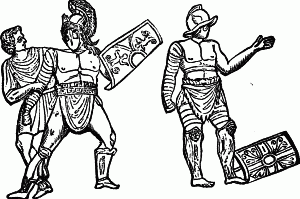
A Samnite was a Roman gladiator who fought with equipment styled on that of a warrior from Samnium: a short sword (gladius), a rectangular shield (scutum), a greave (ocrea), and a helmet. Warriors armed in such a way were the earliest gladiators in the Roman games. They appeared in Rome shortly after the defeat of Samnium in the 4th century BC, apparently adopted from the victory celebrations of Rome's allies in Campania. By arming low-status gladiators in the manner of a defeated foe, Romans mocked the Samnites and appropriated martial elements of their culture.

Pollice Verso is an 1872 painting by French artist Jean-Léon Gérôme, featuring the eponymous Roman gesture directed to the winning gladiator.
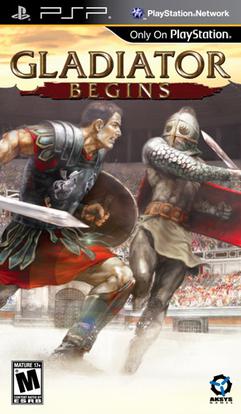
Gladiator Begins is a fighting game developed by Japanese studio GOSHOW and published in Japan by Acquire on January 14, 2010, and in North America by Aksys Games on September 15. It is the prequel to the 2005 video game Colosseum: Road to Freedom, which was originally released for the PlayStation 2.

The Cavillargues medallion is a terracotta relief medallion or plaque of the 2nd or 3rd century, 16 centimetres (6.3 in) across, made under the Roman Empire and found in modern France. It depicts a gladiatorial combat between a retiarius and a secutor. The medallion has been studied by American historian Anthony Corbeill and he believes it shows a games official signalling pollicēs premere, the granting of mercy to fighters whose combat ends in a draw.
